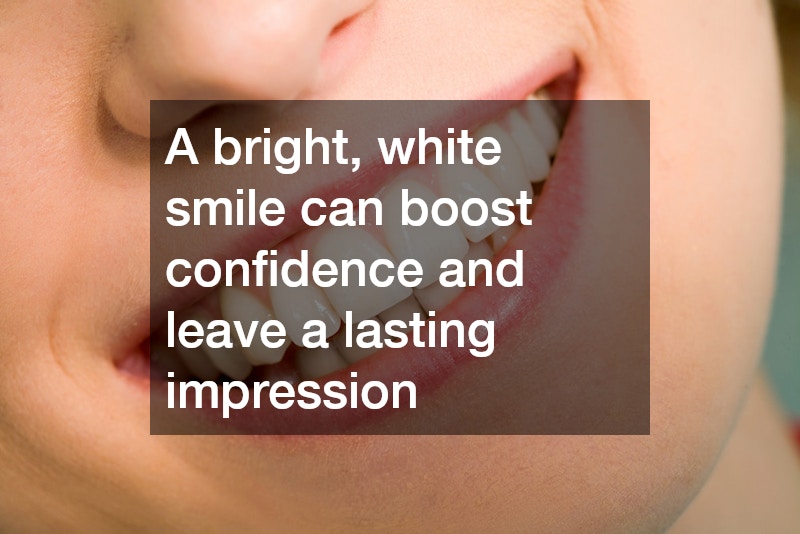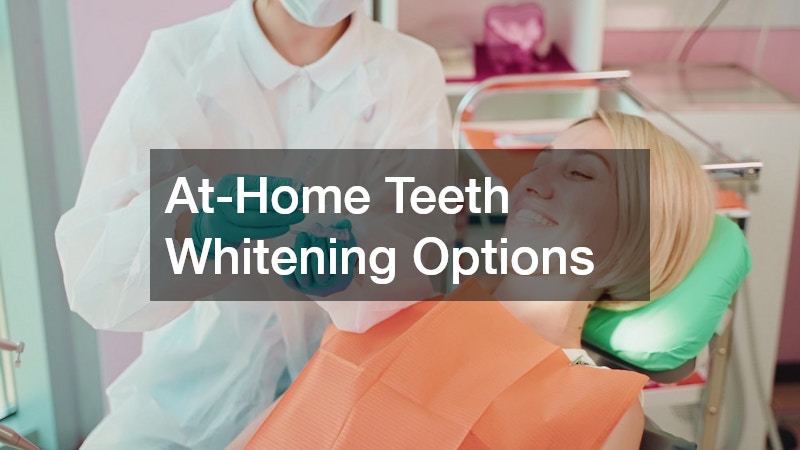
A bright, white smile can boost confidence and leave a lasting impression. Fortunately, modern teeth whitening options make it easier than ever to enhance your smile from home — and with guidance from your dentist, you can ensure your whitening routine is both safe and effective. From whitening strips to LED kits, at-home treatments have become more advanced, convenient, and affordable. This article explores popular whitening methods, their safety, and how to maintain results for a long-lasting, radiant smile.
What Are the Most Effective At-Home Teeth Whitening Methods?
At-home whitening products come in a range of forms, from quick over-the-counter options to customized kits recommended by dental professionals. Knowing the strengths of each method helps you choose what fits your goals and sensitivity level.
Teeth Whitening Strips
Whitening strips are among the most accessible and user-friendly options. They contain a thin layer of hydrogen peroxide or carbamide peroxide to break down surface stains. When worn for 30 minutes daily over one to two weeks, they can noticeably brighten your smile.
Whitening Toothpaste and Rinses
Whitening toothpastes use mild abrasives and polishing agents to remove surface stains caused by coffee, tea, or tobacco. Whitening rinses contain small amounts of peroxide that help maintain brightness. While these methods won’t produce dramatic results, they’re ideal for everyday maintenance.
Whitening Trays and Gels
Whitening trays filled with peroxide-based gels provide a more comprehensive whitening experience. Over-the-counter kits come with standard trays, while custom trays made by your dentist offer a more precise fit and even results. Consistent use over one to two weeks can lighten teeth several shades.
LED Whitening Kits
LED whitening kits pair peroxide gels with light-activated technology. The LED accelerates stain removal, helping users achieve results faster. These kits are popular for combining convenience with near-professional outcomes — especially when used under a dentist’s supervision.
Natural Whitening Remedies
Natural methods like baking soda, activated charcoal, and oil pulling can help remove surface stains, but they should be used with caution. Overuse may wear down enamel, so it’s best to discuss these remedies with your dentist before trying them.
Are At-Home Whitening Products Safe?
Most at-home teeth whitening products are safe when used as directed. However, understanding ingredients and following proper use is essential to prevent irritation or enamel damage.
Hydrogen Peroxide and Carbamide Peroxide
These are the most common whitening agents. Hydrogen peroxide works quickly to lift stains, while carbamide peroxide releases hydrogen peroxide gradually for gentler whitening.
Addressing Tooth Sensitivity Concerns
Temporary sensitivity is normal during whitening, especially for those with thinner enamel. Using desensitizing toothpaste and taking breaks between treatments can minimize discomfort.
Evaluating Gum Health During Whitening
Avoid letting whitening products contact your gums directly, as this can cause irritation. If burning or soreness occurs, stop the treatment and consult your dentist.
The Importance of ADA Approval
Always choose products with the American Dental Association (ADA) Seal of Acceptance. This ensures the product has been tested for safety and proven effective under dental standards.
Safe Duration and Frequency of Use
Follow the manufacturer’s instructions carefully. Overuse can lead to uneven whitening or enamel erosion. Most at-home kits should not be used for more than two consecutive weeks, with maintenance touch-ups spaced out every few months.
How Do At-Home Whitening Kits Compare to Professional Treatments?
At-home whitening is convenient and affordable, but professional treatments remain the gold standard for speed, precision, and customization.
Cost Comparisons and Affordability
Professional whitening treatments are generally more expensive than at-home kits, which tend to be a more budget-friendly option for many patients. At-home options provide excellent value for maintenance or minor discoloration, while professional treatments are ideal for more severe staining.
Effectiveness and Lasting Results
Professional whitening uses stronger peroxide concentrations for faster and longer-lasting results. At-home products can achieve similar results with consistent use, but typically require more time.
Convenience and Time Investment
At-home treatments let you whiten your teeth while relaxing or working, making them convenient for busy schedules. However, professional whitening achieves noticeable results in just one visit.
Professional vs. Over-the-Counter Ingredients
Dentists use higher-grade whitening agents that are customized for your enamel strength and shade goals. Over-the-counter options use lower concentrations for safety, which may take longer to show results.
Monitoring and Adjusting Treatment
With professional whitening, dentists monitor your progress and can adjust treatment strength as needed. At home, it’s up to you to track progress and stop if irritation occurs.
How Long Does It Take to See Results?
Whitening results vary by method, strength, and consistency of use.
Expected Timeframe for Different Methods
Whitening strips and trays typically produce visible results within one to two weeks. Toothpastes and rinses can take several weeks, while LED kits often show improvement after just a few uses.
Tracking Progress and Signs of Effectiveness
Take before-and-after photos under consistent lighting to gauge improvement. Gradual, even whitening across all teeth indicates a successful treatment.
Influencing Factors: Diet and Habits
Coffee, red wine, and smoking can re-stain teeth quickly. Reducing these habits helps preserve your whitening results for longer.
Tips for Accelerating Whitening
Brush before applying whitening products to remove surface buildup. Avoid staining foods and drinks for at least 48 hours after treatment to maximize brightness.
When to Consider Professional Evaluation
If you don’t notice improvement after several weeks, consult your dentist. Deep or intrinsic stains may require professional whitening or veneers for the best outcome.
Achieving a Brighter Smile Safely and Effectively
At-home teeth whitening offers an effective and affordable way to enhance your smile, especially when combined with professional guidance. Consulting your dentist before beginning any whitening regimen ensures the products you choose are safe for your teeth and gums. With consistent care, mindful habits, and routine dental visits, you can maintain a bright, confident smile that shines for years to come.


